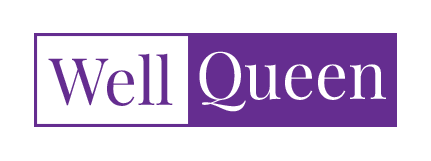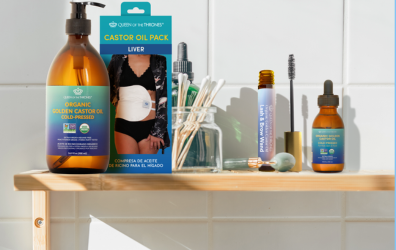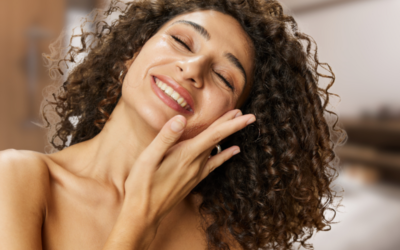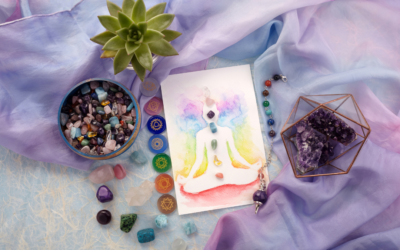The Castor Oil Secret to Beautiful, Healthy-Looking Hair
Have you ever thought about how your hair oiling routine connects you to a deeper history? What if it’s not just about a quick fix for your hair, but a journey through time?
From the comforting glow of 90s hot oil treatments, to the sacred, time-tested rituals of ancient self-care, and even to today’s modern hair care products with their often confusing and misleading labels—there’s more to hair oiling than meets the eye.
In this blog, we’ll explore how these three eras come together to reveal the true art of hair oiling with Castor Oil. Ready to discover the secrets behind healthy-looking, radiant hair? Let’s dive in!
The Power of hair oiling: A timeless practice

Hair oiling has been around for centuries, and for good reason. Whether you’re using Castor Oil, coconut oil, or argan oil, the benefits are numerous.
Castor Oil, in particular, has long been celebrated for its ability to support healthy-looking hair, natural moisturization of the scalp, and vibrant, shinier-looking locks.1 But how did this simple ritual come to be, and what makes it so powerful?
While ancient cultures used oils as part of holistic self-care, the modern practice of hair oiling began to evolve in the 20th century. Fast forward to the 90s, when hair oiling took on a more mainstream appeal with the rise of hot oil treatments. These treatments became a staple in many homes, offering a quick and easy way to nourish hair. But as we’ll see, it wasn’t just the oils that were important—it was the entire experience of hair care that made it a beloved ritual.
Which brings us to a wave of nostalgia that’s making a comeback today when the 90’s hot oil hair treatment was king. This era marked a time when hot oil treatments were the go-to solution for revitalizing hair, and many people still look back on those moments with fondness.
Let’s dive into why the 90s were so special for hair care, and how those hot oil treatments helped launch the hair care trend that’s still going strong today.
The hot oil craze of the 90s
Ah, the 90s—who could forget? Back then, a tiny tube of Alberto VO5 was our golden ticket to shiny, vibrant hair. We’d heat it up in a pot of water, settle in, and imagine the glossy, healthy-looking locks that would soon be ours.
Of course, the intense perfume was almost like a signature, filling the air with a scent that promised transformation—even if it left our scalps feeling a little too tingly or irritated.
In those days, it felt like every product on the shelf promised flawless hair, and we’d buy into it, convinced that if it smelled strong and “luxurious,” it was bound to work. But behind that nostalgic glow, there was a lot more going on—ingredients that were often more about clever marketing than actual benefits.
While we thought we were treating our hair to the best with hot oil treatments, there was a world of complex chemicals and additives that we weren’t paying attention to.
It’s funny how far we’ve come from those days, with today’s hair oiling rituals—like using Castor Oil for hair oiling or a DIY Castor Oil hair mask—focused on more natural, nourishing options. But it’s interesting to look back and see how the beauty industry’s approach to hair care has evolved.
What we once believed were miracles in a bottle were often just temporary fixes, making the true benefits of hair oiling with Castor Oil all the more apparent today.
Fast forward to today, and the world of hair care is full of products boasting “all-natural” labels that promise to nourish and revive our hair. These claims catch our attention, promising a return to the good ol’ days of simple, pure ingredients.
But if you take a closer look at the ingredient list, things aren’t always as natural as they seem.
You might find chemicals like:
- Cocotrimonium Chloride2
- Cetrimonium Chloride3
- Polyquaternium-104
Never heard of the above? Don’t fret, just know that these sneaky chemicals are often lurking at the top of the list—ingredients that sound more like something from a science textbook than nature’s beauty cupboard, agreed?
To make matters worse, manufacturers sometimes rearrange the order of ingredients, putting the natural oils or plant extracts at the top, while hiding synthetic additives further down. This subtle trick creates the illusion that the product is mostly natural and free from harsh chemicals, leaving us to believe we’re getting the best of both worlds—luxurious, healthy-looking hair powered by nature.

The reality? These synthetic additives often overshadow the natural ingredients, which can leave your hair feeling anything but nourished.
This misleading labeling can confuse even the most conscientious consumers, especially those of us seeking natural remedies like Castor Oil for hair oiling or a DIY Castor Oil hair mask. The truth is, not all products labeled as “natural” are created equal. So, while it’s easy to be swayed by those shiny labels, taking a deeper dive into the ingredient list reveals what’s really going into your hair—and it might not always be what’s best for it.
When you opt for hair oiling with Castor Oil, you’re embracing something much simpler and more transparent.
Castor Oil hair benefits5 are well-known and easy to understand, offering a pure, nourishing alternative that doesn’t hide behind any gimmicks. It’s time to rethink the products we trust and go back to basics—giving our hair the care it deserves.
Ancient practices: The true art of hair oiling
Unlike today’s glossy marketing and quick-fix promises, ancient wisdom offers a much deeper perspective on hair oiling. For over 4,000 years, hair oiling has been viewed not just as a beauty treatment, but as a sacred ritual—a practice woven into tradition and rooted in holistic self-care.
Ancient cultures didn’t just use oils like sesame, Castor Oil, and hibiscus for lustrous locks; they understood that true hair care starts with the scalp, the very foundation of vitality and energy.
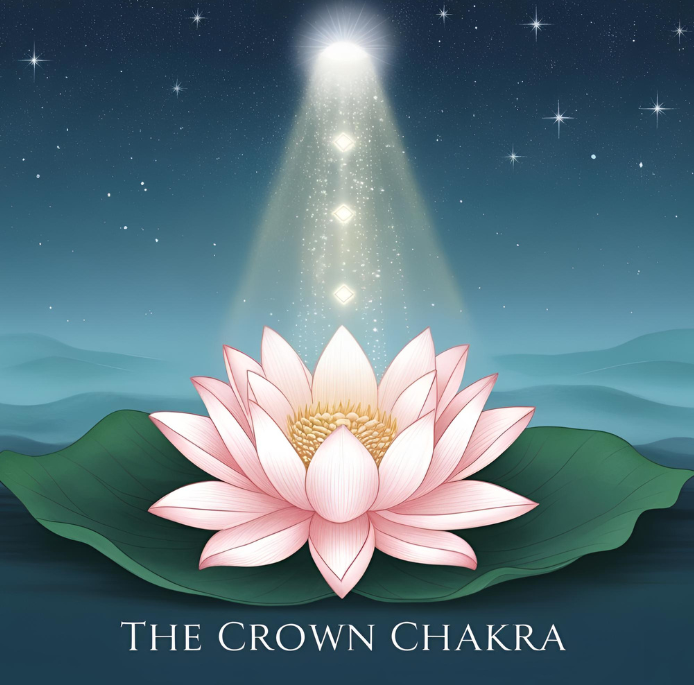
Your scalp is so much more than just the base for your hair—it’s the crown chakra, often referred to as the entry point of divine energy and your personal golden halo, associated with intuition and recognition.6 This energy center is where everything begins, and when you nourish your scalp with genuine, natural oils, you’re doing far more than just giving your hair some love. You’re tapping into an ancient practice that awakens your inner energy, grounding you in balance and vitality.
When you engage in hair oiling with Castor Oil or create a Castor Oil hair mask, you’re not only caring for your hair but also aligning yourself with a tradition that has been passed down through generations.
These oils go beyond surface-level beauty—they help to support and nurture your entire being. So, the next time you indulge in a hair oiling routine with Castor Oil, remember, it’s not just about getting shiny, healthy-looking hair. It’s about honoring a time-tested practice that nourishes both body and soul.
Top oils for natural hair nourishment
When it comes to nourishing your hair, the right oil can make all the difference. Let’s break down some of the best natural oils that have stood the test of time, providing genuine benefits for both your hair and scalp.
Coconut oil
Coconut oil is a classic favorite, beloved for its versatility and heat-resistant properties. It’s packed with fatty acids that help hydrate and protect your hair.7 However, while it works wonders for many, it’s important to be mindful of its tendency to clog pores.
If you have a sensitive or oily scalp, coconut oil might not be the best choice, as it could cause buildup. Always test a small amount first, especially if you’re prone to scalp irritation. For those with thicker, coarser hair, though, it can work like magic, giving hair a smooth, glossy finish.
Olive oil
Olive oil is often touted by celebrities and hair care experts for its moisturizing and smoothing support. Rich in vitamins, it’s a great choice for dry hair and scalp.8 However, its high oleic acid content might not be suitable for everyone—especially those with sensitive skin.
It can sometimes cause irritation or clog pores for people with delicate scalps. If you’ve got thick, dry hair or are looking for natural shine support, olive oil could be your best friend—but it’s best to use it sparingly and always do a spot test first.
Sesame oil
A true gem in Ayurvedic hair care, sesame oil has long been prized for its nourishing and balancing properties. This oil is rich in essential fatty acids9 and vitamins, making it excellent for rejuvenating the scalp and promoting healthy-looking hair.
It’s particularly known for its grounding and calming support, which help balance both the scalp and the body’s energy. If you’re looking for a deeply nurturing oil that connects you to ancient traditions, sesame oil for hair oiling is a perfect choice.
Castor oil
My personal favorite—Castor Oil is a powerhouse when it comes to hydration. Packed with ricinoleic acid, it’s one of the most supportive oils for promoting a healthy-looking hair and scalp nourishment.
Castor Oil not only moisturizes but also supports stronger, smoother-looking hair. Its nourishing properties make it perfect for those with dry or thinning hair, and it’s ideal for anyone looking to support their hair’s natural shine.
If you’re new to hair oiling with Castor Oil, a simple Castor Oil hair mask once a week can work wonders. Just remember, with finer hair, less is more—apply sparingly to avoid weighing hair down. It’s all about nourishing the scalp, the true garden where your hair grows.
For me, hair oiling with Castor Oil has become a weekly ritual—one that deeply nourishes the scalp and rejuvenates my hair from root to tip. Remember, your scalp is the foundation for your hair, and the right oils help keep it balanced and thriving.
So take your time to experiment with different oils and find the one that works best for you.
Nourish your scalp with a simple massage
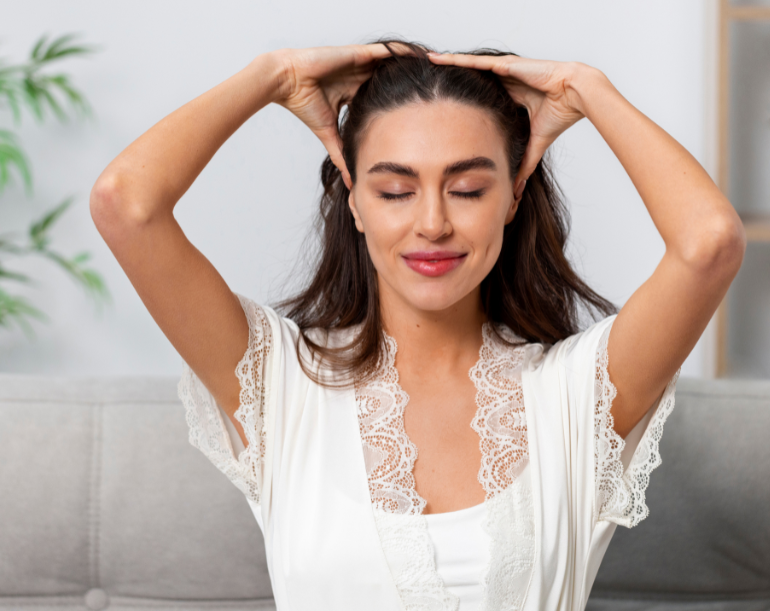
A simple yet powerful addition to your hair oiling routine is a scalp massage—an ancient practice that taps into holistic wellness traditions while also supporting healthier-looking hair.
This ritual goes beyond just relaxing your mind; it revitalizes your scalp and helps bring energetic balance. Plus, it’s an easy and enjoyable way to elevate your hair care regimen with natural oils like Castor Oil or sesame oil for hair oiling.
Here’s an easy step-by-step guide to performing a nourishing scalp massage:
1. Cup Your Hands
Start by gently cupping your ears with your thumbs and index fingers. This position will help center your hands and allow you to focus on the energy flow around your scalp and head.
2. Position Your Palms
Next, place your palms over your cheeks, and allow your fingers to wrap around your head. The goal is to cover as much of the scalp as possible, ensuring that the whole area receives the care it needs.
3. Align Your Fingers
As you settle your hands, let your pinky fingers naturally fall on your temples, and your thumbs should reach the back of your skull. This alignment helps energize specific marma points, which are energy centers that are deeply connected to the body’s overall health and well-being.
4. Apply Gentle Pressure
Now, apply gentle pressure and begin massaging the area in small, circular motions. This energizes the scalp and awakens the powerful energy centers associated with your crown chakra—the entry point for vital energy. As you massage, think of it not only as an opportunity to nourish your scalp but also to connect with the inner energy that flows throughout your body.
This simple technique is an amazing way to enhance your hair oiling routine with Castor Oil or any other nourishing oil.
Whether you’re looking to support healthy-looking hair, or simply relax, this ancient method bridges the wisdom of the past with modern self-care practices. It’s the perfect way to give your scalp and hair the nurturing they deserve while also connecting with a tradition that’s been practiced for thousands of years.
Final thoughts
Modern hair oiling is more than just a beauty routine; it’s a journey that connects the past, present, and future. By embracing the ancient rituals of self-care, while being mindful of today’s often misleading product labels, you can give your scalp and hair the genuine nourishment it deserves.
When you choose natural oils like Castor Oil for hair oiling, you’re not just caring for your hair—you’re awakening your inner vitality, allowing your hair to thrive and shine.
It’s time to reclaim the wisdom of our ancestors and embrace ingredients that truly honor your body’s energy. Focus on nurturing your hair and scalp with oils that are as pure as they are powerful. When you do, you’ll see your hair flourish, and your crown will shine brighter than ever.
If you’ve enjoyed this blend of ancient wisdom, 90s nostalgia, and the modern self-care landscape, we’d love to hear your thoughts! Share your experiences in the comments below, and let’s keep the conversation going.
Let’s celebrate hair care practices that have stood the test of time and continue to empower us today.
Affiliate Disclosure: Some links in this blog post are affiliate links, meaning I may earn a small commission if you make a purchase, at no extra cost to you. Thanks for your support!
References
- McMullen R, Jachowicz J. Optical properties of hair: effect of treatments on luster as quantified by image analysis. J Cosmet Sci. 2003 Jul-Aug;54(4):335-51. PMID: 14528387.\
- PubChem [Internet]. Bethesda (MD): National Library of Medicine (US), National Center for Biotechnology Information; 2004-. PubChem Compound Summary for , Cocotrimonium Chloride; [cited 2025 Mar. 4]. Available from: https://pubchem.ncbi.nlm.nih.gov/compound/Cocotrimonium-Chloride
- PubChem [Internet]. Bethesda (MD): National Library of Medicine (US), National Center for Biotechnology Information; 2004-. PubChem Compound Summary for CID 2681, Cetrimonium; [cited 2025 Mar. 4]. Available from: https://pubchem.ncbi.nlm.nih.gov/compound/Cetrimonium
- PubChem [Internet]. Bethesda (MD): National Library of Medicine (US), National Center for Biotechnology Information; 2004-. PubChem Substance Record for SID 135267623, Polyquaternium 10, Source: ChemIDplus; [cited 2025 Mar. 4]. Available from: https://pubchem.ncbi.nlm.nih.gov/substance/135267623
- Mysore V, Arghya A. Hair Oils: Indigenous Knowledge Revisited. Int J Trichology. 2022 May-Jun;14(3):84-90. doi: 10.4103/ijt.ijt_189_20. Epub 2022 May 24. PMID: 35755964; PMCID: PMC9231528.
- Judith, Anodea. Eastern Body, Western Mind: Psychology and the Chakra System as a Path to the Self. Celestial Arts, 2011. https://books.google.ca/books?hl=en&lr=&id=ewDG5IGkwwEC&oi=fnd&pg=PR7&ots=7WtwxG-oHe&sig=Dh_hGqdsrKogugIk_YNVprRZcho&redir_esc=y#v=onepage&q&f=false
- Wallace TC. Health Effects of Coconut Oil-A Narrative Review of Current Evidence. J Am Coll Nutr. 2019 Feb;38(2):97-107. doi: 10.1080/07315724.2018.1497562. Epub 2018 Nov 5. PMID: 30395784.
- Abdalla S, Aroua MK, Gew LT. A Comprehensive Review of Plant-Based Cosmetic Oils (Virgin Coconut Oil, Olive Oil, Argan Oil, and Jojoba Oil): Chemical and Biological Properties and Their Cosmeceutical Applications. ACS Omega. 2024 Oct 25;9(44):44019-44032. doi: 10.1021/acsomega.4c04277. PMID: 39524627; PMCID: PMC11541506.
- Wei P, Zhao F, Wang Z, Wang Q, Chai X, Hou G, Meng Q. Sesame (Sesamum indicum L.): A Comprehensive Review of Nutritional Value, Phytochemical Composition, Health Benefits, Development of Food, and Industrial Applications. Nutrients. 2022 Sep 30;14(19):4079. doi: 10.3390/nu14194079. PMID: 36235731; PMCID: PMC9573514.
Castor Oil 24/7: One Oil for Beauty, Balance & Beyond
Hi, I’m Dr. Marisol, founder of Queen of the Thrones®. And if you’re anything like I was—exhausted by long routines, frustrated with breakouts, and standing in front of a cluttered shelf of half-used beauty products—know that I see you. I was you.
The Ultimate Castor Oil Nighttime Routine for Soft, Glowing Skin
Did you know the average woman uses 12 beauty products a day—and most of them at night? Yep, that used to be me too.
Reconnect to Your True Self: Ground Your Chakras with Castor Oil Packs
Ever catch yourself stressing over your body? Whether it’s the cellulite, that little pooch you can’t seem to shake, hair that never looks quite right, or skin that feels like the Sahara
